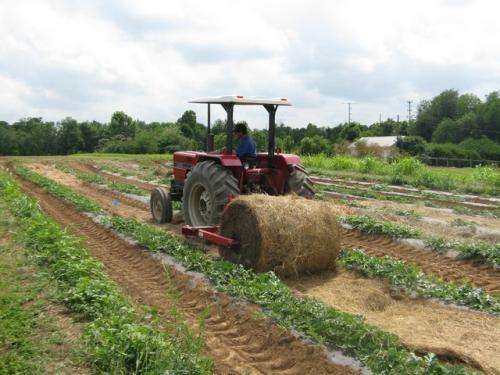New bale unroller design deemed effective

John Wilhoit and Timothy Coolong from the University of Kentucky have introduced a new technology that can make the application of organic mulches more efficient. The research team from the University of Kentucky premiered their new invention in the August issue of HortTechnology. The team altered a conventional round-bale unroller and designed experiments to document its efficiency. "We modified an unroller so that the new design would be offset a sufficient distance for the tractor to straddle the row of plastic and unroll the bale in the space between adjacent rows of plastic," explained Wilhoit and Coolong. "Then, we tested the efficacy of the modified unroller with several types of organic mulches for between-row weed control in organic watermelon. Mulching between rows can be an effective practice for controlling weeds; our modification makes mulching with round bales of hay or wheat straw more efficient."
For the experiments, the offset round-bale unroller was used to apply hay and wheat straw mulch to between-row areas of 'Crimson Sweet' watermelon in 2009 and 2010. The mulches were applied at two thicknesses: one or two layers unrolled from round bales. "The results showed a significant mulch-type by year interaction for weed control," the authors said. "One-year-old hay had less impact on weed control in 2010 compared with 2009, whereas other mulches had improved weed control in 2010. One-year-old wheat straw and new hay had the lowest levels of weed biomass compared with new wheat straw and the no-mulch control."
The experiments also proved that the thickness of the mulch affected weed control, with mulches applied in two layers resulting in significantly less weed biomass than those applied in one layer.
"These results suggest that hay and wheat straw mulches can be an effective weed control practice when used in conjunction with cultivation," Wilhoit stated. "Weed control with all of the mulches was significantly better than the control. Our results also indicated that adequate weed control could be achieved with a single layer of mulch, reducing costs for mulching with round bales. The hay and wheat straw mulches were effective in weed control, even at application rates in the 15,000 to 20,000 pound-per-acre range."
"Our results showed that an offset bale unroller can make mulching of vegetable crops more efficient. The mulches used in our study are commonly available and relatively inexpensive in Kentucky. However, our offset bale unroller design could likely be used with other mulches that may be more commonly available in other regions of the United States," the authors concluded.
They added that any conventional bale unroller can be modified like the one used in the study "provided the clamping arms are open at the end where they pivot on the toolbar, allowing the additional length of toolbar to be welded on."
More information: horttech.ashspublications.org/ … nt/23/4/511.abstract
Provided by American Society for Horticultural Science
















